Reduce energy consumption, minimize CO₂ emissions:
Volkswagen uses EC+ for sustainably good ventilation
It is not only the production process that determines the CO₂-neutrality of companies. The energy-efficient air conditioning of office and manufacturing buildings also makes a decisive contribution to the sustainable operation of production facilities. Here, air-conditioning and building services solutions play an essential role in an efficient, energy-saving overall system. To achieve this, Volkswagen chose an EC+ solution from Danfoss in close cooperation with Novenco, a major manufacturer of fans. It is used at VW’s Navarra plant in Spain. There, modern air handling technology (AHU) now provides energy- and cost-efficient ventilation in one of the plant’s largest assembly halls. Volkswagen manufactures the VW Polo and the T-Cross there.
Volkswagen Navarra: Pioneer for sustainable ventilation technology
For the automotive manufacturer Volkswagen, sustainability plays a central role in all production processes. In this context, ‘sustainable’ stands for the responsible use of the environment and natural resources. VW is also implementing this step by step in building technology and is converting to a new generation of air conditioning systems at some locations. These AHU solutions include Novenco axial fans, high-efficiency PM motors and AC drives from Danfoss. They make an important contribution to greater energy and cost efficiency in all areas of ventilation and air conditioning – including in one of the largest assembly halls at the VW plant in Navarra, Spain. Reduced resource use and decarbonization measures are the declared goal here. Innovative RLT is to continuously reduce energy consumption and the associated CO₂ emissions at the site.
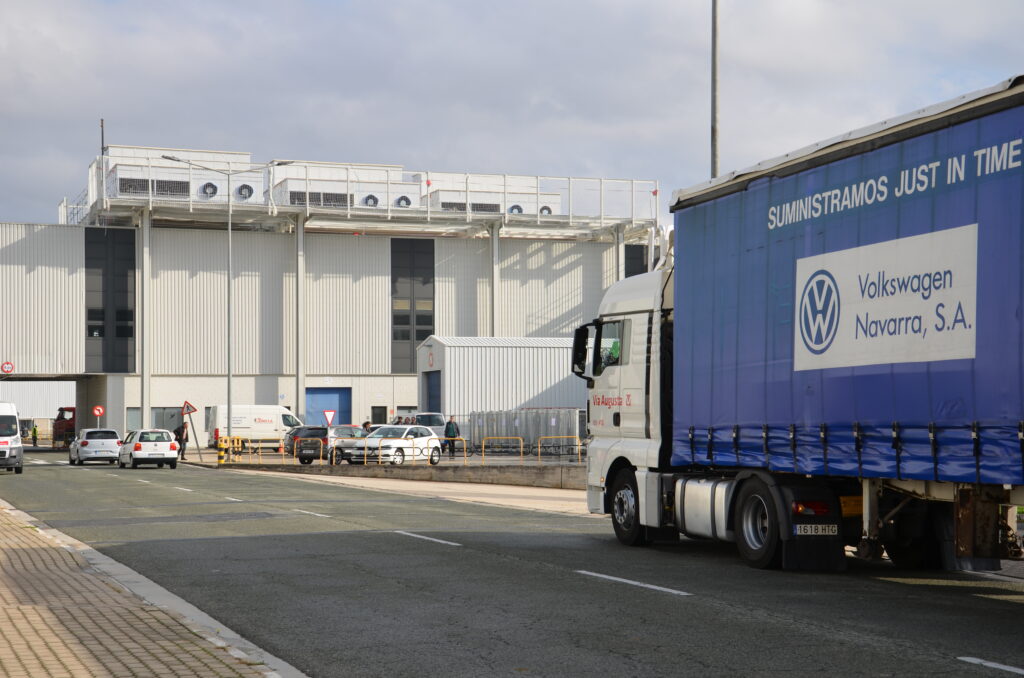
Volkswagen has already been testing sustainable air conditioning technologies for its assembly halls since the beginning of 2017 with a series of measurements and field tests. The aim is to explore the technical possibilities of high-efficiency air handling systems for ventilation in automotive manufacturing. In 2018, the automotive group then took the next step together with Novenco and Danfoss Drives: VW invested in the Navarra site and completely renewed the ventilation system in its largest production hall. Numerous special aspects had to be taken into account: On the one hand, the production hall required higher air volumes, and on the other, the space available for installing the system was no longer sufficient. In addition to energy savings, unit size, weight savings and noise reduction were therefore also key requirements in the project. A new installation location on the roof was chosen for the AHUs. Trubel Klimatechnik, a technical building equipment supplier from Eschwege in Germany, commissioned the project and installed the large 80,000 m³/h units on a steel platform above the transition between two halls.
Virtual tour: This is how energy-efficient ventilation works at the VW plant
Martin Groll, Head of Sales at Novenco’s German subsidiary, and Gerold Kronthaler, HVAC expert from Danfoss Drives, explain step by step how the HVAC solution works, which ensures good air in a sustainable and energy-efficient way at VW’s Navarra plant. The project at a glance: The air volume of 420,000 m³/h is moved by three AHUs with 80,000 m³/h each and three AHUs with 60,000 m³/h each. Twelve highly efficient axial fans are installed in parallel operation and with an aerodynamic design for maximum pressure boosting. VLT® HVAC Drive FC 102 control the speed of the axial fan systems efficiently and allow for high energy-savings. In the future, AC drives from Danfoss will be able to do much more than purely speed control. Gerold Kronthaler explains how VW Navarra could also use predictive maintenance concepts for the ventilation system in the future with intelligent frequency converters. The so-called condition-based monitoring – that is the condition monitoring of the fan system with AC drives – can monitor the life cycle of the components and make optimum use of it. This contributes to the conservation of resources. If the VLT® Pressure Transmitter Unit PTU 025 is also used, the FC 102 detects the degree of contamination of the filter. For this purpose, a limit value adapted to the plant can be set in the AC drive. The filter contamination and air flow rate are shown on the display of the VLT® HVAC Drive. This is attached to the outside of the air handling units at VW Navarra and can be read effortlessly at any time. Alternatively, the values can be output to the higher-level controller via a field bus. Without sensor technology, the AC drive might waste energy at some point due to increasing filter clogging. The advantage of the PU 025 is therefore obvious: the filter can be replaced as needed and at the optimal time. This saves effort, costs and resources compared to the alternative of replacing the filter after a fixed time interval regardless of the condition and therefore possibly too early. Take the virtual tour and discover what role the individual components play and how the optimal interaction of fans, motors and AC drives enables maximum energy and resource efficiency in the ventilation system compared to a given complete solution from one supplier.
Sustainable ventilation technology: VW saves 20% energy and 350 tons of CO₂
Volkswagen relies on the EC+ concept from Danfoss and Novenco for the ventilation of one of the largest assembly halls at the Navarra plant. EC+’ stands for the intelligent interaction of the optimally selected system components such as AC drive, motor and fan. In this way, the new air handling system at the VW plant offers maximum energy and cost efficiency. Because ultimately, drive technology is the key technology for greater energy efficiency in fans and pumps through speed control. Compared with the previous ventilation system, the 6 new AHUs have a combined total savings potential – based on nominal operation per year – of 747,429 kWh of electrical energy, 350 tons of CO₂ and 199,115 € in electricity costs in the first year. This calculation results for an energy price of 26.64 Cents/kWh. Other underlying assumptions of the calculation are the CO₂ emission factor of 468 g/kWh and 8,760 annual operating hours. In addition to these significant energy and cost savings, the new units are also 30 percent shorter and lighter.
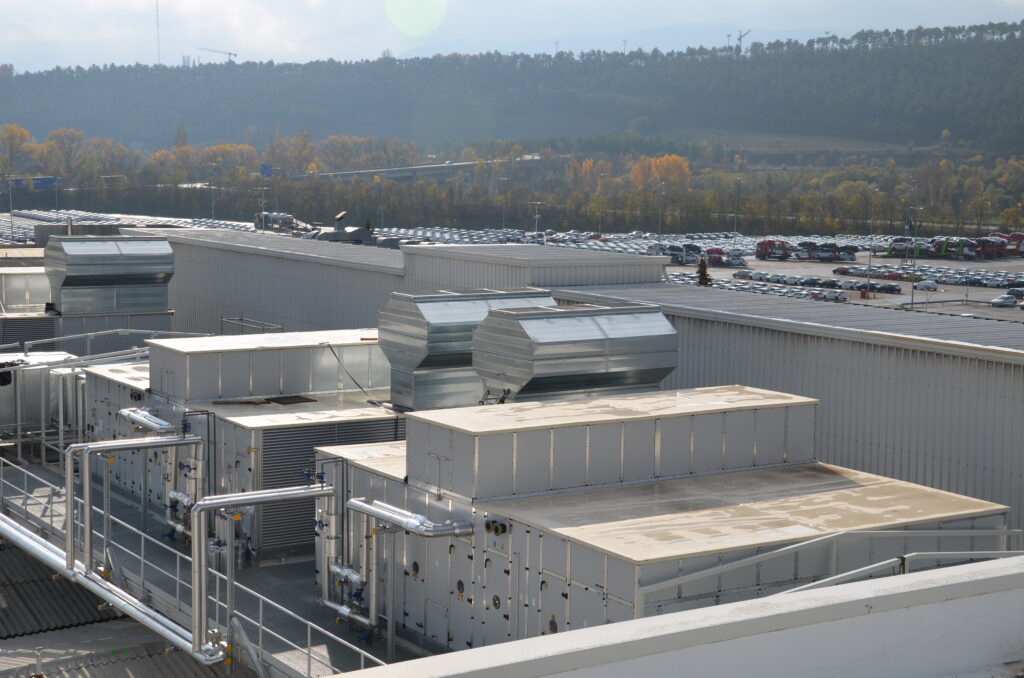
EC+: 'Air' plays a major role for energy-efficient buildings
In companies, and in the automotive industry in particular, air conditioning and building technology solutions are a key factor in an efficient, energy-saving overall system. This is exactly where the EC+ concept from Danfoss and Novenco comes in. ‘EC’ stands for a combination of an efficient fan with an efficiency of about 92%, a high-efficiency PM motor with an efficiency of about 95% and an AC drive from Danfoss Drives with an efficiency of 98%. Thus, an overall efficiency of the fan system of about 85 % is realized. Martin Groll from Novenco and Gerold Kronthaler from Danfoss explain the role that speed control of fans and air-conditioning technology plays for the automotive industry – and what else is part of sustainable building design. Keyword: life cycle management and recycling.
Do you already know the energy efficiency champions in your factory buildings?
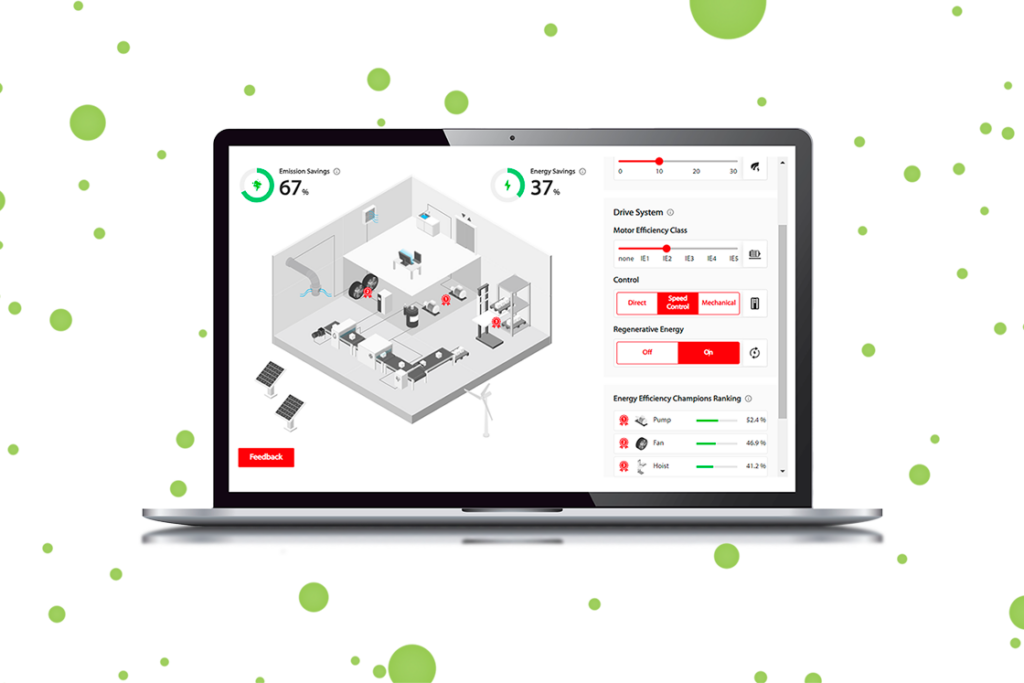
Energy is and will remain expensive. In addition, companies must reduce CO₂ emissions as part of their ESG targets. Many companies therefore invest in renewable energies such as photovoltaics on the roof or purchase green electricity. But is that enough?
Discover the hidden energy efficiency champions on your factory building in the EcoChampion Finder. You will learn which settings will save you the most energy, costs and emissions at the same time.
By the way, the example building in our online tool has the same dimensions as the Danfoss production site in Graasten, Denmark. All value quantities of the savings and the related calculations are related to the dimensions of this building. Start playing your energy efficiency match now!
Checklist: 9 tips for energy efficiency in fans and pumps
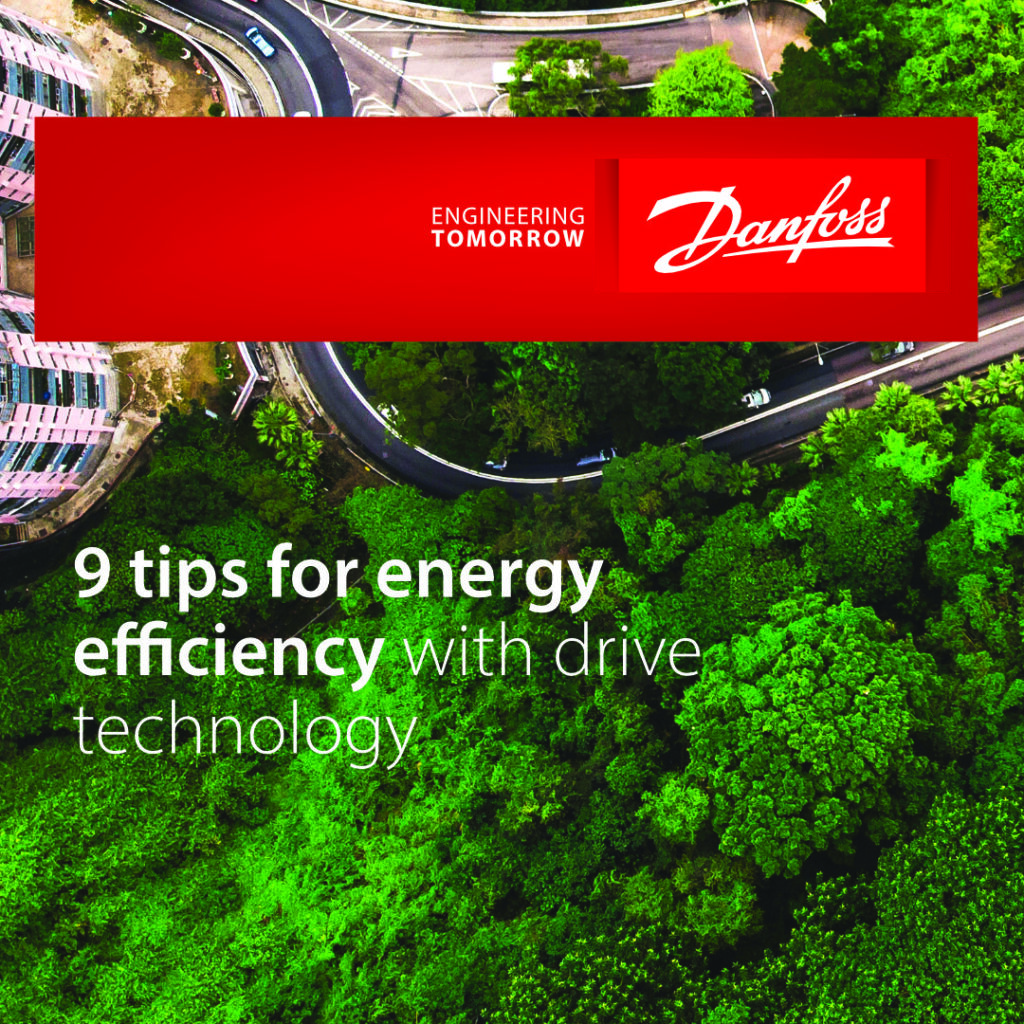
It is time to consider energy-saving measures in existing buildings to sustainably increase efficiency. In this way, companies also keep the rising costs of energy under control in the best possible way. Did you know that in the first step you can easily and quickly realize energy savings by speed controlling fans and pumps? With the 9-point checklist for energy-efficient AC drives from Danfoss Drives, you can quickly get an overview of the energy guzzlers in your buildings.
At the same time, the checklist highlights general measures you can take to increase energy efficiency through speed control. You will learn where you can start immediately to increase efficiency and reduce costs in the process. Ultimately, drive technology is a key technology for greater energy efficiency in your plants and processes. It is currently the most effective and simple solution to significantly and immediately reduce energy consumption. Download the energy efficiency checklist now to achieve success easily and quickly.
Energy crisis - incentive for more efficiency?
All episodes of the podcast season at a glance
In the podcast season "Energy crisis – incentive for more efficiency?" we go on an energy efficiency journey – from green hydrogen to storage technologies and DC supply in industry. For this, we have invited lots of energy experts. They explain how the industry must position itself technologically for the next few years and what should be done in terms of energy policy.
In episode 1/4 of the season, listen to podcast host Robert Weber. He wonders how we could have slid into the current situation – when technologies and also political incentives for more energy efficiency and the use of green energy have been available for a long time. In the process, he lets guests from the previous podcast episodes have their say again on the topic of energy and innovation.
Episode 2/4 of this podcast season welcomes Sebastian Weckmann, Head of the Industrial Energy Systems Department at Fraunhofer IPA, and Helge Vandel Jensen, Director Business Development Electrification at Danfoss Drives, who are absolute experts in new ways of industrial energy supply. What energy sources can we use in the future? How quickly will the energy supply transformation succeed? What can industrial companies do now? Episode 2/4 provides answers to this.
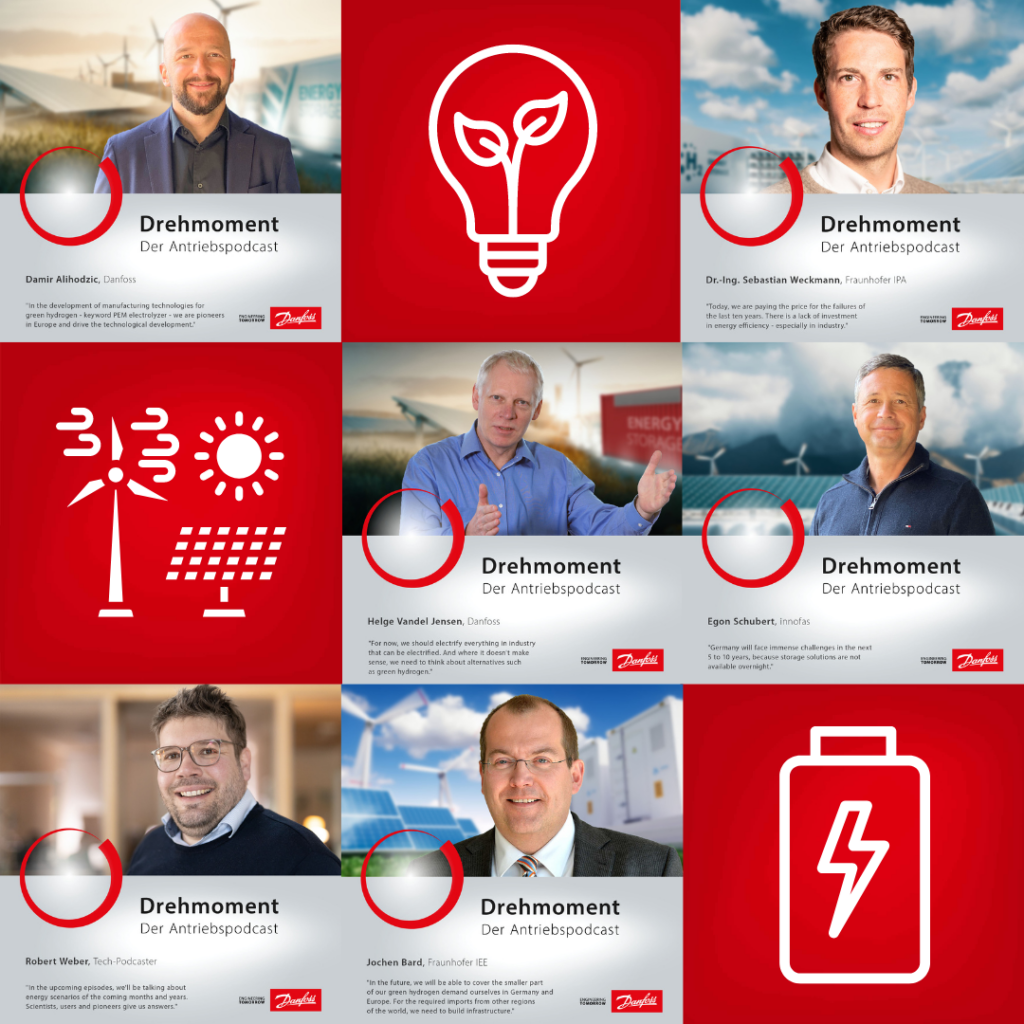
The whole world is talking about green hydrogen: In episode 3/4 of the season, host Robert Weber talks to Jochen Bard from the Fraunhofer Institute about this special energy carrier. Will Europe become the hydrogen champion through self-production? Or will we import green hydrogen? If so, from where and how can it be transported? Danfoss expert Damir Alihodzic adds expertise about the production of hydrogen, the so-called electrolysis, to this episode. He knows what technology is used to build big electrolysers and shares that knowledge with you in the podcast episode.
Last but not least, the season finale with Egon Schubert from Innofas and Reiner Kaiser from Danfoss Drives offers a very good and deep insight into the world of decentralized energy storage technology. What about the stability of our power grid? What can storage facilities contribute here? How and, above all, how quickly can companies integrate decentralized storage? That’s what host Robert Weber discusses with his guests in this episode.
Do you like Torque – The Drive Podcast? Then subscribe to it on Spotify or Apple Podcasts.
